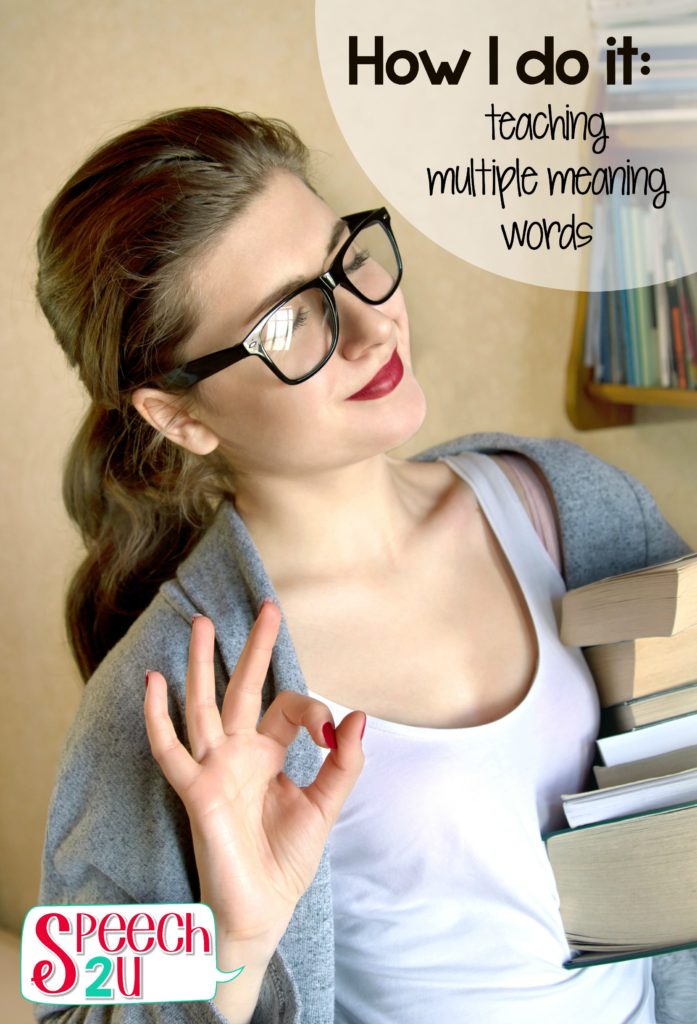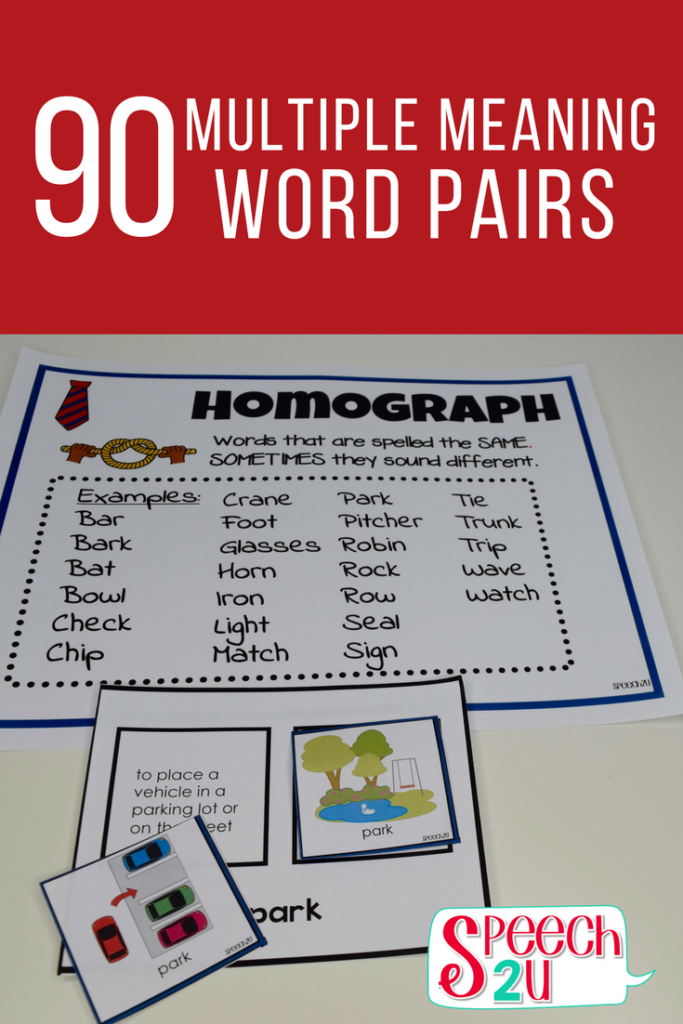The ability to understand multiple meaning words is important for children to process language, humor and to have a robust vocabulary. Does anyone else feel overwhelmed when trying to choose the vocabulary to teach? How many words should we be teaching and when should we stop this type of instruction?

What is a good end point with multiple meaning words?
I like to start by thinking about my end goals. Having a good understanding of what “finished” will look like helps guide my therapy. It’s especially helpful in the murky middle of therapy when I may be struggling with our next steps or goals to be added for a student or client. So what is a good end point for vocabulary goals? Seriously, can you tell me? We can’t teach every single multiple meaning word that is out there. I couldn’t find a good research study that suggests how many multiple meaning words you would need to teach to see generalization. Here is what I look for:
- I want the student to demonstrate understanding that words can have more than one meaning
- I want them to be able to use words that have more than one meaning in a sentence or in conversation.
When we first start therapy, I may need to use lots of cues to help them learn the vocabulary. Over the course of the year, I hope that they are starting to use some strategies that we have been talking about in therapy.
What multiple meaning words should I target?
I like to work from a list (because it is convenient for me.) I try to be realistic about how many targets I can teach over the course of the year. I’ve seen the numbers 7-8 words per week floating out there in regular education literature. Most of my students need more practice learning the words, so I may introduce 3-5 words per week. The average school year is 40 weeks but I’m going to take 4-5 weeks out as students may be absent, on field trips etc and to give myself time to review words that they need additional help with. So, I might be teaching 100-180 words over the course of a school year. Once I know my target number, I can also work with the teacher and use the child’s classroom textbooks to pull common multiple meaning words for use in my speech room.
How should I teach or target multiple meaning words?
This is the fun part. How to structure the session to maximize a child’s learning while also making it relevant and interesting for them? I always introduce multiple meaning word pairs using pictures so that my students can visualize the differences. Here are some other activities we do to practice multiple meaning words in my speech room:
Receptive identification tasks
- Find/point to the multiple meaning word given a definition.
- Identify the multiple meaning word in a joke
- Highlight the multiple meaning word in a sentence.
- Find and highlight multiple meaning words in a text
- Identify the correct definition given a set of definitions
Expressive tasks
- State the meaning of a multiple meaning word using a graphic organizer.
- State the meaning of both words using a graphic organizer.
- Explain how the meaning would change if you used the other multiple meaning word.
- Explain how a multiple meaning word made a joke funny.
Here are three fun games to target multiple meaning words within your speech room:
Can’t Say It:
The following book pictures include affiliate links for your convenience. Affiliate programs allow bloggers to receive a small percentage of the sales of a product. There is no additional cost to the reader and it helps with the costs of maintaining and running a blog. These are all books that I own, and no one paid me to review or comment on them.
I use a picture flap book I purchased years ago to introduce the concepts. I have the student pick one picture to define and then I will define the other. We use a semantic mapping strategy to help define our words ( a lot of times I use the Expanding Expression Tool (EET).
I have a few picture books which show simple multiple meaning words. I have the child pick one to define and then I have to define the other. I may use the EET tool to help them define it or we may work on defining using synonyms or antonyms. I love to play-“Can’t say it” where I get points if they define the word by saying, “stuff, thing, or use the vocabulary word in the definition.”
Brian Cleary has a bunch of resources that are good for introducing language concepts. This book has a variety of illustrated homonym pairs in sentences such as: “A flea can flea.” I’ve also used this book as a reference to play a Zoom zinger homonym game:
In the game, you replace a pair of homophones/homonyms with a description/definition and the student has to guess the multiple meaning word. For example:
- May you pass that tine container (can)
- Can I go to the party the month after April? (may)
- Why don’t we celebrate with cooked bread? (toast)
- The glowing sphere is not heavy. (light)
Joke It Up
I love using jokes in therapy. Kids love humor and they don’t realize that they are working when we share them. Marvin Terban has a few books that focus on homonym or homophone riddles. For example how does a moose begin a letter to his cousin? Dear Deer. (Insert groan here).
Can the student identify the word that means more than one thing? Can they define each one? Why did the multiple meaning word make the joke funny?
Amelia Bedelia
I loved her books as a child. She is a very black and white thinker and it’s easy to find some examples of how she confused the meaning of a word.
Is this really my job? Am I just doing what the teacher is doing?
We offer different services than a teacher or a tutor would. The use of hierarchies, multiple opportunities for learning are different from what a typical classroom teacher is doing. We support students with cues and prompts and change them frequently within sessions to increase our student’s understanding and performance. We take time to break down goals to help an individual student grasp a concept or idea.
Multiple Meaning Word Goals:
I use the total number of words I’ve decided to teach to help write my goal. It might look something like, “In order to demonstrate understanding and use of multiple meaning words, Student will be able to generate a sentence containing a multiple meaning word, taken from a list of 100 words previously targeted in therapy sessions, within a one year period for 90% of targeted words.” Once the long term goal is written, I can write my short term objectives-how am I going to get there. Some possible benchmarks:
- The student will identify the correct mm word used in a sentence by pointing to the picture with 80% accuracy.
- The student will match mm words within a picture activity.
- The student will define mm words given 4 choices.
- Given one definition of a mm word pair, student will define the other mm word.
- The student will identify mm words within a joke (or text).
- The student will define one mm word within a joke (or text)
- Student will define both meanings of mm word within a joke (or text)
- Student will explain how a mm word brought humor to a joke.
- Student will use a mm word within a sentence.
Check out next week’s post with some of my favorite online resources for teaching multiple meaning words.
Looking for a comprehensive product to systematically teach multiple meaning words? You may want to check out:







What a fabulous explanation! Thanks for breaking this down and providing excellent examples and resources. I also use a Bingo game to reinforce the MM words after they are taught, just to give increased exposure and reinforcement in a fun way.
What I also loved about this post on MM was your explanation of how we are different from a teacher teaching MM. This would be a great explanation to give when an SLP is being observed and the observer does not understand why we respond to students in certain ways (ex:prompt hierarchy).
Thank you for your comment. Bingo is a fun game! Great idea.